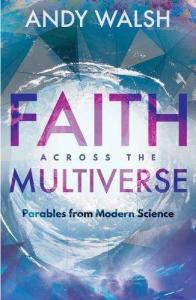 I recently received a copy of a new book courtesy of the author and publisher, Faith Across the Multiverse by Andy Walsh. This book is not your typical science and faith book, but it should prove an interesting read as we work through several of the main concepts Walsh introduces. This opening chapter (numbered 0 rather than 1) is titled The Power of Babel Fish using a concept from Douglas Adams “Hitchhiker” books. Translation is inevitable and essential. Our thinking is constrained, if not confined, by the language we use. Metaphors and analogies make important connections bringing understanding.
I recently received a copy of a new book courtesy of the author and publisher, Faith Across the Multiverse by Andy Walsh. This book is not your typical science and faith book, but it should prove an interesting read as we work through several of the main concepts Walsh introduces. This opening chapter (numbered 0 rather than 1) is titled The Power of Babel Fish using a concept from Douglas Adams “Hitchhiker” books. Translation is inevitable and essential. Our thinking is constrained, if not confined, by the language we use. Metaphors and analogies make important connections bringing understanding.
It is also true that the same word can be used in different communities or contexts to mean very different things. Walsh uses the word “vector” as an example, contrasting its use in physics, molecular biology, the mapping of infectious diseases, and computer science. Although there are often points of connection in the various uses (but not always) it is still necessary to translate the meaning from one field to another.
What does this have to do with science and faith? There are several points of connection. First, the Bible frequently uses examples from nature (‘science’) to illustrate the nature of God and his relationship with creation. These metaphors and analogies make a crucial connection for human comprehension. They help to translate God into a language we can understand.
Second, Walsh points out that God reveals himself through relationships with people so that all could come to know him (special revelation) as well as through his creation (general revelation). This is not a novel concept, but Walsh makes a specific connection with Christ as revelation. New concepts are hard to develop and communicate – but a new concept and new language was needed.
But going a layer deeper, we see that Jesus himself is the ultimate expression of both general and special revelation. He was part of the physical world and lived his life to illustrate concepts that would otherwise have been inconceivable, such as a king who washes the feet of his subjects, a prophet who teaches on his own authority, and a priest who sacrifices himself. He also came with specific teachings from God to share with his disciples, to explain those ideas he was illustrating with his life. For this reason he is described as the Word of God; he was the word we needed to add to our language to be able to talk about all these principles. (p. 7)
Third, natural theology. Natural theology has something of a bad reputation among scientists, even many Christian scientists. It is attached to the attempt to somehow prove the existence of God. There have been many missteps along the way. The proof of God from nature is connected in the minds of many to gaps only God can fill. But finding God in gaps rather than in the whole of creation is troublesome. As scientific understanding increases, the gaps decrease. Beyond this, however, we should expect to find God in the entirety of creation, in what is well understood as well as in the mysterious. Walsh doesn’t go into this much, but he does adopt the two books analogy, where God reveals himself in nature and in Scripture. If God is the author of both there should be indications of this authorship in both general and special revelation, just as the works of favorite composers or authors are recognizable. Dorothy Sayers reads like Dorothy Sayers. Douglas Adams like Douglas Adams, etc.
What does this mean for natural theology? Walsh elaborates:
Why shouldn’t it be the same with the physical world? … God collaborates with creation itself to realize the ultimate form of that creation. If this is true, then a close reading of the physical world should also shed light on God’s perspective. And if God is any good at his craft, then some consistent sense of his personality should be evident in both of his major works, motivating the work of natural theology.
Furthermore, we would expect that the more we learn and understand, the more these commonalities would be evident. The language, the metaphors, the mental tools we acquire from learning to talk about the physical world should be relevant to topics from scripture, perhaps even clarifying concepts whose nuances are challenging to describe because we don’t have the words. If, on the other hand, there is no common author, then modern scientific ideas should find no analogue in the Bible. As products solely of human thought at the time, the books of the Bible could scarcely contain notions for which their human authors lacked the mental framework to even contemplate. (p. 20)
It isn’t that the Bible contains modern science hidden in its pages. Nor are we searching for proof of God’s existence though God-sized holes in our explanations. Rather, natural theology (Walsh’s version) looks for evidence of authorship through conceptual framework. In this book he seeks to see how modern science can help us better make sense of the words written in Scripture. He will explore themes from mathematics, physics and computer science.
Walsh’s style is entertaining and easy to read – although his ideas are more complex than they seem on the surface. It will be interesting to see where he goes as he looks for connections and indications of God’s authorship in the physical world.
How do you understand natural theology?
Is Walsh’s approach different? Could it be useful?
If you wish to contact me directly, you may do so at rjs4mail[at]att.net.
If interested you can subscribe to a full text feed of my posts at Musings on Science and Theology.
















